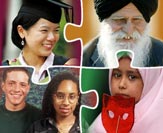Related pages
External links
Did you find this page useful?
Page information
This page was last updated on 04 July 2007
Guiding principles for choosing ethnic categories
Your ethnic data must be comparable with census output data
You should make sure that the question you ask to collect information about people's ethnic origins is the same as, or very similar to, the census question. For example, any changes, especially to the order of the categories, may affect the way some people answer the question and, so, make your comparisons less reliable.
If you decide to introduce extra ethnic groups to those used in the census, these should be added as sub-groups of the appropriate main ethnic group in the census question, or the CRE amended question.
For example, Somali would be a sub-group of Black African, under the Black or Black British heading, and Sri Lankan would be a subgroup of ‘other’ under the Asian or Asian British heading. You can then combine the data for these sub-groups with the data for the main census group, so that you can compare the categories used in census output data.
If you are in doubt about where to include an extra group, you should talk to someone in the Integration and Harmonisation Division of the Office for National Statistics for England and Wales, or the User Needs and Geography Branch of the General Register Office for Scotland (GROS). You should be careful about adding extra categories (but see note on Gypsies and Irish Travellers below).
You may want to commission special, more detailed census tables for your local population, and compare your own data with these. Again, the Office for National Statistics (and GROS) can advise you about this.
Your ethnic question must be widely acceptable
The way people classify themselves can change. For example, the devolution of powers to the Scottish Parliament and the National Assembly for Wales reflects an increasing sense of identification with the individual countries that make up Great Britain. Similarly, some Black African and Black Caribbean groups are beginning to express concern about being labelled ‘Black’. This is why GROS has decided to use different categories for its census output data.
Evidence shows that people are more willing to answer questions about their ethnic background so long as the questions are acceptable. You should remember that the ethnic question was widely tested before it was used for the census, and that the question achieved a high response rate when the census was carried out.
Your ethnic data must be as detailed as possible
You should collect and analyse ethnic data in as much detail as possible. This is because using only broad or ‘headline’ categories can hide important differences between groups, for example between Bangladeshis and Indians under the Asian or Asian British heading. Also, if you do not ask for detailed information the first time, you may have to ask for it again if you need to look more closely at differences between ethnic groups.
Another reason to use the full set of census categories is that, from time to time, we may ask you for data, so that we can monitor whether public authorities are meeting the general duty and the specific duties in relation to race equality. We shall ask for the information on the basis of the categories that were used for the census output data in England and Wales, and in Scotland.
Include separate categories for Gypsies and Irish Travellers
In the CRE's 2006 report into equality, race relations and sites for Gypsies and Irish Travellers, Common Ground, we recommended that local authorities add two separate categories for Gypsies and Irish Travellers in all ethnic monitoring arrangements. You should also take steps to encourage them to provide information about their ethnicity.
Housing associations should include Gypsies and Irish Travellers in ethnic monitoring systems, and all other public bodies should consider doing the same.
For more information, see:
